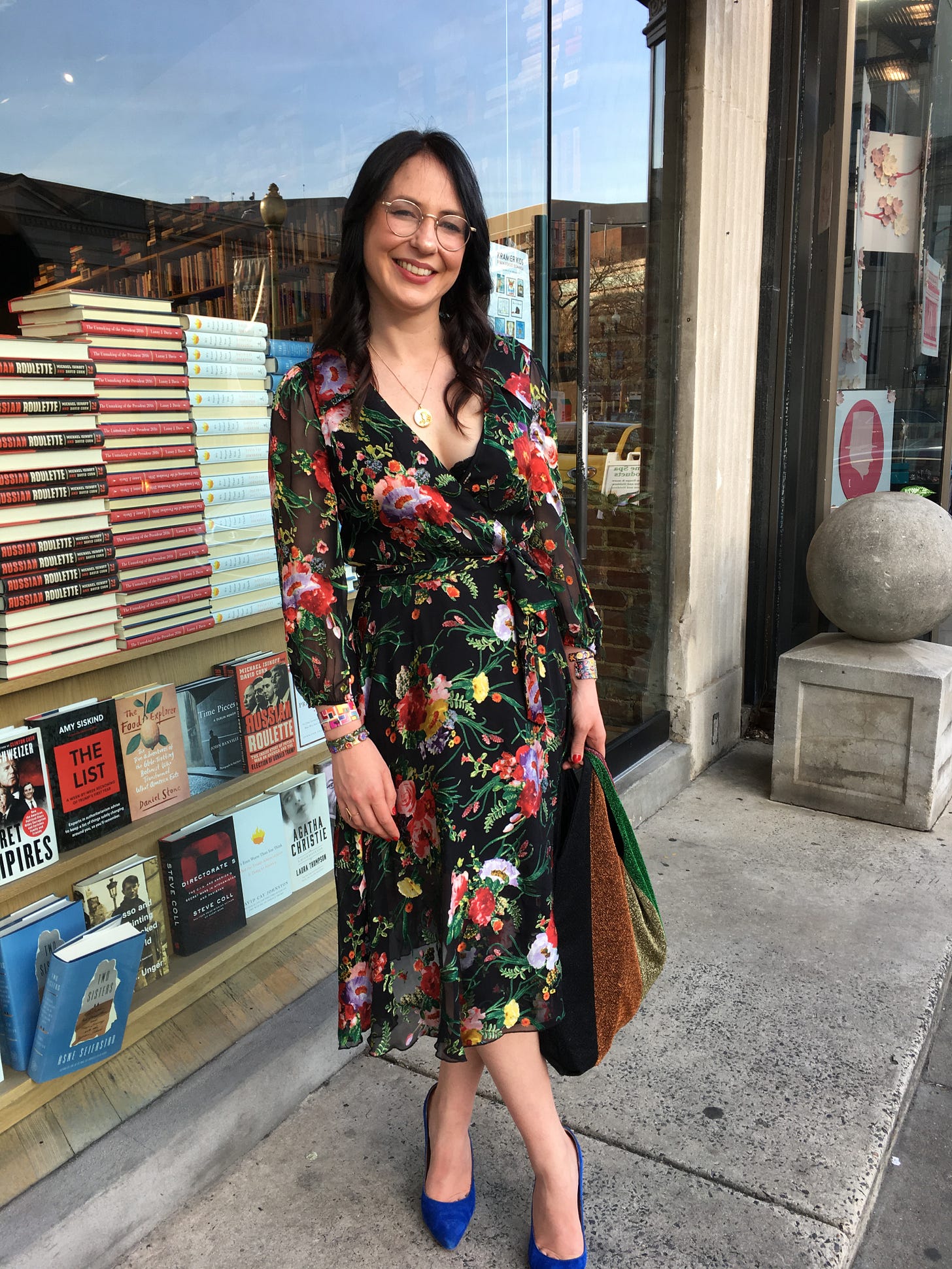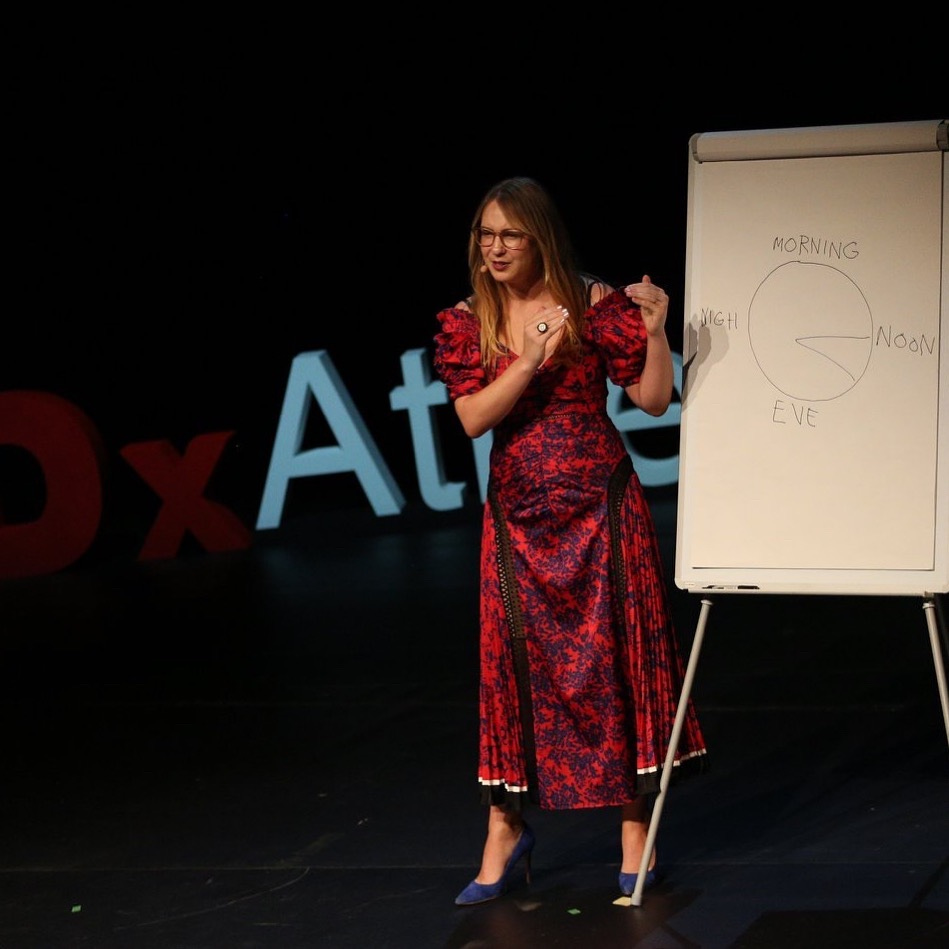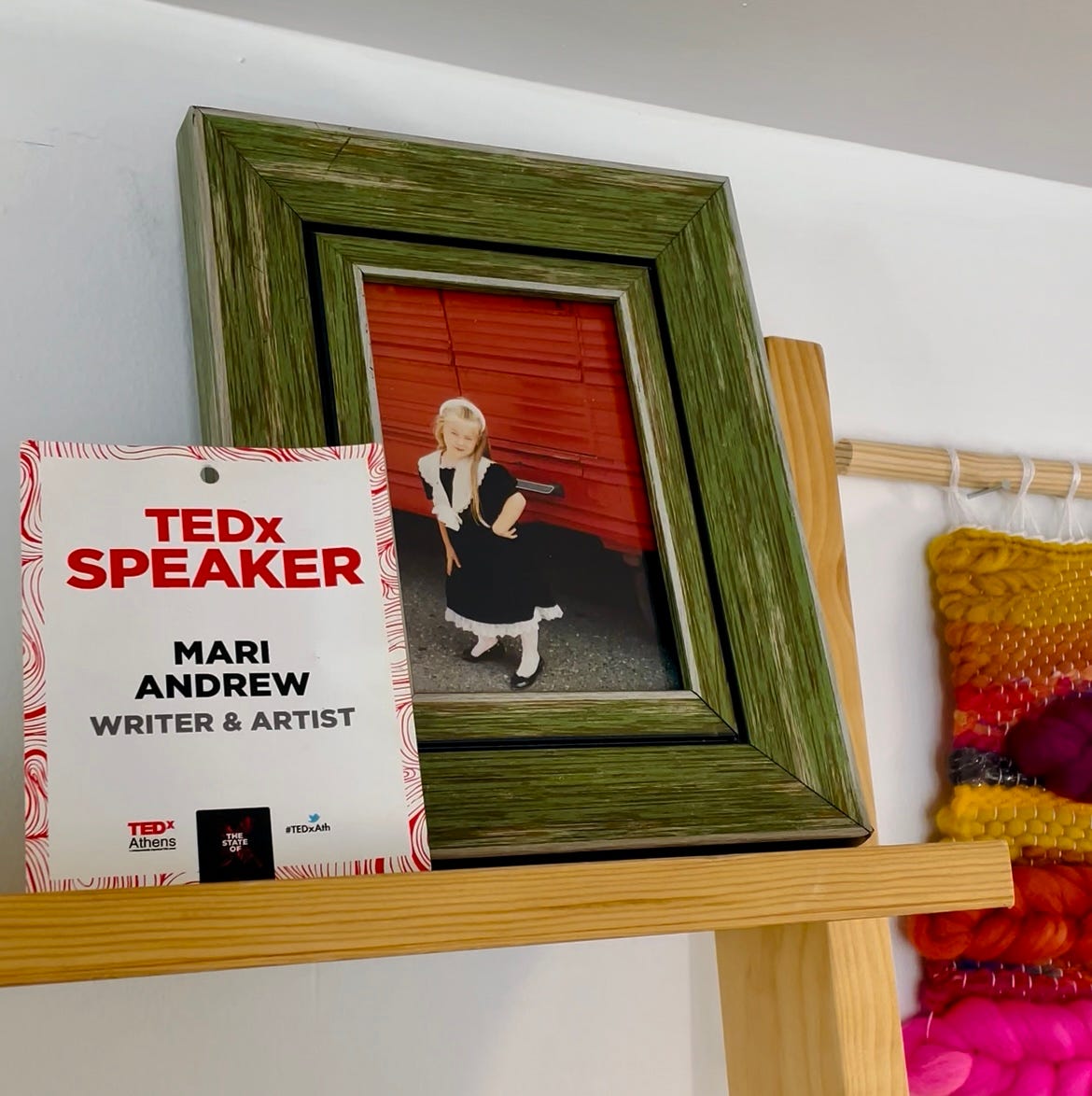Fun thing first!
Time Magazine (heard of them??) published an abridged excerpt from my new book! Read here:
How I Learned to Love My Body—Especially in the Summer
Now, about speaking to people…
Of all the things I do in this line of work (uh, squiggle of work?), public speaking is my favorite part.
This is a tad curious for a person who is terrified of public speaking.
No matter how many times I do it, I get nauseating stage fright and obnoxious physical manifestations of my nerves—dry mouth, shaky hands, stomach flips, the whole shebang.
Xanax helps. Wine helps.
But now I have book release events coming up and the mystery guest in my tummy isn’t allowed to have either substance, so I’m on my own and trying to remember my pre-prescription tricks.
First, I have to remember why I actually do enjoy it—in spite of all the cartoonish panic symptoms that blast on to the scene the minute I even think about it.
I like talking to people. I like hearing from people.
More than anything, I like finding the one or two people in the audience who give a lot of feedback and energy (head nods, laughter at my dumb jokes, addictive eye contact) and pretending that this stranger and I are in a one-on-one dialogue where I have nothing to prove—just some thoughts to share.
That’s when I remember what I’m doing up there in the first place: sharing something that’s important to me. What a privilege.
Below, before my first ever book release event: Nauseated, about to faint, and completely angry that my mom wanted to take a picture
And after my first ever book release event: Feelings of supreme aliveness
If you, like me, get satisfaction from talking to a group (that includes a group of two!) yet you transform into a timid mouse (at least on the inside!) when you’re in the position to do so, here are a few tips I’ve picked up.
From one mouse to another…
Everyone just wants to feel good!
I had a yoga teacher once who was absolutely wonderful and brimming with confidence. Teaching seemed so easy and effortless for her. And thus, I loved her classes very much.
I had just started teaching creativity workshops, and asked for her secret.
“Oh, I used to get really nervous in the beginning,” she replied. “But then I realized, everyone just wants to feel good.”
And it’s so true!
Nobody goes to yoga hoping to be impressed with the teacher, or blown away by how many tricks they know and how many sequences they have memorized.
People go to yoga to feel good afterwards. Whether they even remember the teacher doesn’t matter; the class is a success if everyone feels better than they did walking in.
This is something I’ve had to remind myself over and over while planning speeches, retreats, or my entrance to a party:
People have a good time if they feel good about themselves. And sometimes, trying to be impressive and use fanciful phrasing and talking about all the experiences you’ve ever had in life makes people NOT feel good.
For instance, before I host a shindig at home, my husband always reminds me to keep some clutter around the house. I would rather erase any signs that a human has ever lived in our apartment; I Tasmanian-Devil-myself around, shoving toothbrush holders in cupboards and swinging tote bags into closets and hiding the silly books behind the important books.
But people feel a lot more comfortable at a home when they walk in and there are signs of life. Like, the life of someone who actually exists in reality. And might even own a toothbrush.
Did you know that, in conversation, people perceive YOU as interesting if THEY feel interesting?
So, if you’re at a party and you meet a Scuba diver and all you do for two hours is ask them about the wide world of Scuba, that aquatic explorer will walk away from your chat thinking, “That person was so interesting to talk to!” Even if they could not name a single fact about your life.
I think about this while speaking. Everybody wants to feel connected, valuable, empowered, and interesting.
While it wouldn’t work for a public speaker to ask personal questions of the audience the entire time, the speaker can make the audience feel all those ways with general personal prompts, like, “Have you ever experienced that?” or “Can you think of a time when you felt the same way?”
Sentiments such as, “Wow that person is smart” or “They did well at that speech” last mere moments. Sentiments like “That conversation put me in a good mood” or “I can do that too” can last in some way or another forever.
And they want to understand what you’re saying.
Counterintuitive but effective:
When answering a question—in an interview or just a casual conversation—I’ve noticed a tendency in myself to start the answer with a banger of a response…and THEN back it up with some rambling until I reach a point where I’m just saying words because I think they’re supposed to be there.
The Pro Way to answer a question is to start off with the rambling, and then make the point at the end. So, the order is: back up your point, then make your point.
People remember the last thing you say more than the first. Psychologists call this the “recency effect”: we tend to hold on to the most recent piece of information we’ve heard.
So if you're answering a question or giving a talk, think about what you want echoing in their minds after you're gone. The final beat—not the first—is the one that stays.
Likewise, when giving a talk with multiple points, my secret little strategy is to only remember the final sentence of each section, so I know where I’m headed. It’s like a cute mental map where you know the destination but you have multiple ways to get there—options! Fun!
Below, notes for my TED talk scribbled on my fingers (around my tattoo), which were all the “landing places” of the points I wanted to be sure to make. (Yes, one of those landing places was “lobster—solitude"!)
The speaker is the mentor, not the hero.
In her famous TEDx talk, Nancy Duarte introduces a structure for speeches that mirrors the narrative arc of great storytelling.
The core of it is an oscillation between:
“What Is” – the current reality or status quo
“What Could Be” – the better future or new idea you're proposing
By toggling back and forth between these two states, speakers create tension and contrast, which builds momentum and keeps the audience emotionally engaged.
But much more importantly, the speech then includes the audience.
This structure isn't about showing how great the speaker or their idea is. Instead, it's about inviting the audience into a shared journey. Here's how it works:
The speaker is the mentor, not the hero. The audience is the hero of the story.
You’re not there to shine a spotlight on yourself, but to help them overcome a challenge or embrace a new vision (or even just embrace your ramblings on a topic you enjoy!).
Duarte’s framework shows that a successful speech isn't a performance for the audience—it's a conversation with them. It’s not about delivering information at them, but about crafting a journey with them.
You move from “Here’s what I see” to “Here’s what you can become.”
Here are a few monumental examples:
Barack Obama – “Yes We Can” (2008)
Examples of “What Is”:
“We’ve been told we cannot do this by a chorus of cynics… They will only grow louder and more dissonant.”
He references ongoing political division, economic hardship, and disbelief in progress
Examples of “What Could Be”:
Repeating the empowering phrase: “Yes we can.”
Tying the present to the past: “Yes we can to justice and equality. Yes we can to opportunity and prosperity. Yes we can heal this nation. Yes we can repair this world.”
Why it works:
It wasn’t just inspiring—it made people feel like they belonged to the idea. He doesn’t just say ‘Here’s what I’ll do,’ he says ‘Here’s what we’ve done together, and what we can still do.’ The power doesn’t lie in Obama’s vision alone; it lies in helping the audience see themselves inside that vision.
Martin Luther King Jr. – “I Have a Dream” (1963)
Examples:
“I have a dream” is the repeated refrain that points to what could be — a future of racial harmony and equality.
He contrasts that with stark realities like “the Negro lives on a lonely island of poverty in the midst of a vast ocean of material prosperity.”
Why it works:
King doesn't lecture; he invites the audience to dream with him. He shows them that they are part of building that better future.
Steve Jobs – iPhone Launch (2007)
Examples:
He mocks existing smartphones: “They all have these plastic little keyboards.”
Then reveals Apple’s alternative: “Today, Apple is going to reinvent the phone.”
Why it works:
Jobs doesn’t just sell a product—he positions the audience as part of a moment in history. He pulls them into the excitement of change.
Then there is the bad use of this good structure:
Cult leaders and certain U.S. presidents have this in common: They create a problem, then name themselves as the only solution.
That’s why so many hurting people feel seen by speakers who don’t have their best interests in mind. Especially from a charismatic voice or group, it can be overwhelmingly compelling to hear, “This is a problem you have, and I’m the one to solve it.” Everyone wants a quick-fix savior!
So, with that in mind, remember to be a mentor, rather than a hero or savior. Unless you’re trying to start a cult; then being either is a sure bet.
What does this have to do with your life, you wonder??
Neither you nor I are MLK Part 2 or Steve Jobs The Sequel, but every single human being has influence in this world—even at a dinner party with an audience of four champagne-sipping aristocrats, or in a stuck elevator with an audience of one grumbling maintenance worker.
When you’re speaking to a dog or an auditorium of people, you have to build trust right away or you run the risk of watching everyone doze off in relative unison.
And the fastest way to build trust is to name the reality plainly (“Here’s what’s happening”) and invite in an idea.
I absolutely love complaining and gossiping with friends, but I my attention would not be long for this world if a speaker expounded their list of personal complaints with no invitation for engagement.
One of my famous pet peeves (I think I mentioned it ten times in my new book oops) is the sentiment “The world is burning” or “This year is a dumpster fire” or “We live in hell.”
They don’t speak to reality; they speak to a fear-hubris hybrid that shuts down the conversation. Naming reality looks more like, “This is a scary time, huh?” and bringing the audience on an imaginative voyage from there.
Show the love.
On my journey toward becoming a halfway decent Pan-Latin-dance enthusiast, I often ask my various teachers for tips on how to make my moves look better even if they’re the basic of the basic.
My dear fabulous bachata instructor gave me a good one: She said, “As soon as you finish a short choreography of steps, give a dramatic and proud look back at the place where you just danced. That final flourish says with the body, ‘Look what I just did, and how much I loved doing it!’”
Whether you spun and shuffled perfectly or fell on your tush more than once, the final flourish says “TA-DAAAA!” no matter what, and shows the fun you had and the love you put into your dance.
It’s like a dance version of this adorable meme, which will be me in August:
Love is contagious. I would rather sit through a 3-hour lecture on something I’m not remotely interested in if it’s taught be someone who adores the subject, rather than a tight “perfect” speech on something the speaker has zero passion for.
One of life’s pleasures is getting to listen to someone who just LOVES what they’re talking about; you get to enter the love affair with them for a moment in time and absorb all those love-feelings through osmosis as though you’re a part of their relationship. Maybe it’s like being at a wedding or witnessing a proposal or seeing a dog and human reunite in a TikTok.
I don’t know about you, but the teachers and professors I most fondly remember are the ones who were nuts about their chosen subject (they were also usually the strangest characters, which helped lodge them in my memory).
It was very clear which ones were hired to teach a subject they could not possibly have less interest in, and the ones who had a bonkers-in-love relationship to history or astrobiology or puppet arts.
When my mom first met my now-husband, I was curious if she had been anxious or had any intentions going in to the conversation.
“I just wanted him to know how much I love you,” she said.
And now, that’s the spirit I take with me when I’m speaking. I just want the audience to know how much I love this. They will get what they need from there.
I used to have to occasionally present during small meetings when I had an office job. I was always horribly nervous about it and dreaded the presentation all week.
What helped was realizing that I could really harness my enthusiasm as a strength here. Did I care about the job? No. Did I care about some aspect of the job? For sure. So long as I conveyed my care and zest about SOMETHING, then I did my work.
Whether or not I was nervous and said “um” the whole time didn’t matter for long after I did my presentation version of a bachata flourish at the end: Look what I just did, and how much I loved doing it!
When I get nervous before speaking, I ask myself what’s really going on. More often than not, it’s a desire to appear competent, authoritative, and smart, and maybe even to sell a book or two.
But when I switch that desire from being perceived a certain way to getting to talk about something I love, my body responds beautifully. I’m less anxious and more excited, less results-focused and more “I’m so lucky to be here in the first place”-focused, and much more forgiving of my own mistakes.
If you’re talking about how much you love your pet turtle, does anyone care that you didn’t articulate that feeling perfectly? No! They’re just enjoying being a witness to your love for Slowpoke.
That said, everyone is on your side.
Whenever I have to talk to anyone I don’t know well—whether I’m on stage or going on a friend-date—I automatically think of all the reasons why they are about to criticize me, be bored, or leave while I’m mid-sentence.
But something I learned from the Dallas Cowboys Cheerleader docu-series is: Don’t eliminate yourself first. That means, when you’re auditioning to be a cheerleader as you so often do, don’t leave the studio thinking, “There’s no way I’m going to make it.” Let the judges be the one to decide that.
The nice thing about speaking to other people is that there are no judges involved. Just the ones in your head. :)
What helps me get this in my brain is that I go to a lot of theatre, fitness classes, and gatherings where I might be in the position of asking a stranger about their life. And in all those scenarios, I am always on the ‘performer’s’ side.
I get so stressed when a Cardio Blast instructor doesn’t think they’re doing a good job because they keep messing up the right and left or whatever, because usually I’m having such a fine old time and want them to enjoy themselves too!
No one is ever satisfied when a speaker or actor or stranger gets their words mixed up and loses their train of thought, but everyone has been there. Audiences of any size are rooting for the talker!
In my various experiences with many many humans, I learn and re-learn that people are at least 50% more compassionate than you think they are, and ultimately we want others to do well—and for their own sake.
When you fumble, you’re not letting anyone down. Find that one super-engaged person in the audience, or the light behind the eyes of the stranger in front of you, and assume (correctly!) that they’re right there with you, cheering you on, enjoying the journey, and looking forward to where you’re about to take them next!
Announcements about my upcoming book!!
*If you pre-order from Strand Bookstore, you get a signed copy and specially-designed bookmark!
Support an independent bookstore AND get a signature filled with love!
*If you pre-order from ANYWHERE, you get a free tutorial video I made about needle felting (see examples here)!
Just enter your pre-order information in this form and you’ll get immediate access to the video!
*I have two book release events coming up…
July 15: I’ll be storytelling on stage at Sixth and I in Washington DC, but the event will also be streamed virtually so you can watch from anywhere at any time if you register. RSVP HERE!
July 18: I’ll be at Strand Bookstore in New York City. RSVP HERE!














Gahhhh can't believe 7-8 years ago I was scouring through ur IG & love-osmosis-ing all your doodles & ramblings w/o an idea of who you were, other than what u posted.... To OOTB where I was like YES she has more to say & share & she's doing it here, what a privilege it is to get to hear what she's been thinking about...
To TED talk!!!!????!!!!!! So wild where you have flown in life, big things coming too with little Mari sloshing around inside, you are one of my favourite living things, I am so happy for you 💕😘 I love you & the bonus is I love how you make me feel!
This was so great to read! I have found myself doing a lot of public talks and thus watching the Duerte Ted Talk etc to figure out what I was doing, and everything you say here is true and a such great reminder! Congrats on the next book! Excited to read it!